内核中dump_stack的实现原理(2) —— symbol
环境
正文
static __printf(, )
void __check_printsym_format(const char *fmt, ...)
{
} static inline void print_symbol(const char *fmt, unsigned long addr)
{
__check_printsym_format(fmt, "");
__print_symbol(fmt, (unsigned long)
__builtin_extract_return_addr((void *)addr));
}

/* Look up a kernel symbol and print it to the kernel messages. */
void __print_symbol(const char *fmt, unsigned long address)
{
char buffer[KSYM_SYMBOL_LEN]; sprint_symbol(buffer, address); printk(fmt, buffer);
}
/**
* sprint_symbol - Look up a kernel symbol and return it in a text buffer
* @buffer: buffer to be stored
* @address: address to lookup
*
* This function looks up a kernel symbol with @address and stores its name,
* offset, size and module name to @buffer if possible. If no symbol was found,
* just saves its @address as is.
*
* This function returns the number of bytes stored in @buffer.
*/
int sprint_symbol(char *buffer, unsigned long address)
{
return __sprint_symbol(buffer, address, , );
}
/* Look up a kernel symbol and return it in a text buffer. */
static int __sprint_symbol(char *buffer, unsigned long address,
int symbol_offset, int add_offset)
{
char *modname;
const char *name;
unsigned long offset, size;
int len; address += symbol_offset;
name = kallsyms_lookup(address, &size, &offset, &modname, buffer);
if (!name)
return sprintf(buffer, "0x%lx", address - symbol_offset); if (name != buffer)
strcpy(buffer, name);
len = strlen(buffer);
offset -= symbol_offset; if (add_offset)
len += sprintf(buffer + len, "+%#lx/%#lx", offset, size); if (modname)
len += sprintf(buffer + len, " [%s]", modname); return len;
}
上面的第11行的kallsyms_lookup就是根据address获取size,offset,modname
/*
* Lookup an address
* - modname is set to NULL if it's in the kernel.
* - We guarantee that the returned name is valid until we reschedule even if.
* It resides in a module.
* - We also guarantee that modname will be valid until rescheduled.
*/
const char *kallsyms_lookup(unsigned long addr,
unsigned long *symbolsize,
unsigned long *offset,
char **modname, char *namebuf)
{
const char *ret; namebuf[KSYM_NAME_LEN - ] = ;
namebuf[] = ; if (is_ksym_addr(addr)) {
unsigned long pos; pos = get_symbol_pos(addr, symbolsize, offset);
/* Grab name */
kallsyms_expand_symbol(get_symbol_offset(pos),
namebuf, KSYM_NAME_LEN);
if (modname)
*modname = NULL; ret = namebuf;
goto found;
} /* See if it's in a module or a BPF JITed image. */
ret = module_address_lookup(addr, symbolsize, offset,
modname, namebuf);
if (!ret)
ret = bpf_address_lookup(addr, symbolsize,
offset, modname, namebuf); found:
cleanup_symbol_name(namebuf);
return ret;
}
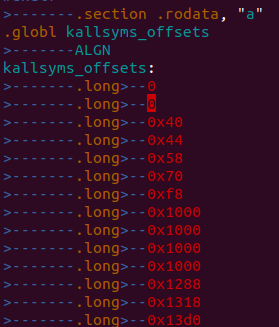
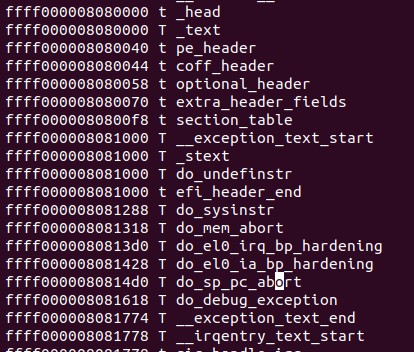
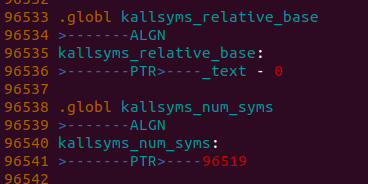

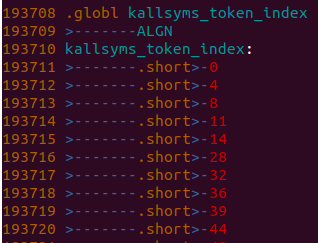
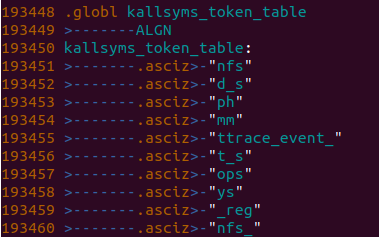
static unsigned long get_symbol_pos(unsigned long addr,
unsigned long *symbolsize,
unsigned long *offset)
{
unsigned long symbol_start = , symbol_end = ;
unsigned long i, low, high, mid; /* This kernel should never had been booted. */
if (!IS_ENABLED(CONFIG_KALLSYMS_BASE_RELATIVE))
BUG_ON(!kallsyms_addresses);
else
BUG_ON(!kallsyms_offsets); /* Do a binary search on the sorted kallsyms_addresses array. */
low = ;
high = kallsyms_num_syms; while (high - low > ) {
mid = low + (high - low) / ;
if (kallsyms_sym_address(mid) <= addr)
low = mid;
else
high = mid;
} /*
* Search for the first aliased symbol. Aliased
* symbols are symbols with the same address.
*/
while (low && kallsyms_sym_address(low-) == kallsyms_sym_address(low))
--low; symbol_start = kallsyms_sym_address(low); /* Search for next non-aliased symbol. */
for (i = low + ; i < kallsyms_num_syms; i++) {
if (kallsyms_sym_address(i) > symbol_start) {
symbol_end = kallsyms_sym_address(i);
break;
}
} /* If we found no next symbol, we use the end of the section. */
if (!symbol_end) {
if (is_kernel_inittext(addr))
symbol_end = (unsigned long)_einittext;
else if (IS_ENABLED(CONFIG_KALLSYMS_ALL))
symbol_end = (unsigned long)_end;
else
symbol_end = (unsigned long)_etext;
} if (symbolsize)
*symbolsize = symbol_end - symbol_start;
if (offset)
*offset = addr - symbol_start; return low;
}
/*
* Find the offset on the compressed stream given and index in the
* kallsyms array.
*/
static unsigned int get_symbol_offset(unsigned long pos)
{
const u8 *name;
int i; /*
* Use the closest marker we have. We have markers every 256 positions,
* so that should be close enough.
*/
name = &kallsyms_names[kallsyms_markers[pos >> ]]; /*
* Sequentially scan all the symbols up to the point we're searching
* for. Every symbol is stored in a [<len>][<len> bytes of data] format,
* so we just need to add the len to the current pointer for every
* symbol we wish to skip.
*/
for (i = ; i < (pos & 0xFF); i++)
name = name + (*name) + ; return name - kallsyms_names;
}
/*
* Expand a compressed symbol data into the resulting uncompressed string,
* if uncompressed string is too long (>= maxlen), it will be truncated,
* given the offset to where the symbol is in the compressed stream.
*/
static unsigned int kallsyms_expand_symbol(unsigned int off,
char *result, size_t maxlen)
{
int len, skipped_first = ;
const u8 *tptr, *data; /* Get the compressed symbol length from the first symbol byte. */
data = &kallsyms_names[off];
len = *data;
data++; /*
* Update the offset to return the offset for the next symbol on
* the compressed stream.
*/
off += len + ; /*
* For every byte on the compressed symbol data, copy the table
* entry for that byte.
*/
while (len) {
tptr = &kallsyms_token_table[kallsyms_token_index[*data]];
data++;
len--; while (*tptr) {
if (skipped_first) {
if (maxlen <= )
goto tail;
*result = *tptr;
result++;
maxlen--;
} else
skipped_first = ;
tptr++;
}
} tail:
if (maxlen)
*result = '\0'; /* Return to offset to the next symbol. */
return off;
}
内核中dump_stack的实现原理(2) —— symbol的更多相关文章
- 内核中dump_stack的实现原理(3) —— 内核函数printk的实现
参考内核文档: Documentation/printk-formats.txt 在内核中使用dump_stack的时候可以看到如下用法: static inline void print_i ...
- 内核中dump_stack的实现原理(1) —— 栈回溯
环境 Aarch64 Qemu aarch64-linux-gnu-gcc linux-4.14 概述 栈回溯的目的是将函数的调用栈打印出来,对于分析函数调用和debug系统异常会很有帮助 ...
- 内核中dump_stack()的实现,并在用户态模拟dump_stack()【转】
转自:https://blog.csdn.net/jasonchen_gbd/article/details/44066815?utm_source=blogxgwz8 版权声明:本文为博主原创文章, ...
- linux内核中打印栈回溯信息 - dump_stack()函数分析【转】
转自:http://blog.csdn.net/jasonchen_gbd/article/details/45585133 版权声明:本文为博主原创文章,转载请附上原博链接. 目录(?)[-] ...
- Openvswitch原理与代码分析(5): 内核中的流表flow table操作
当一个数据包到达网卡的时候,首先要经过内核Openvswitch.ko,流表Flow Table在内核中有一份,通过key查找内核中的flow table,即可以得到action,然后执行acti ...
- Linux 2.6内核中新的锁机制--RCU
转自:http://www.ibm.com/developerworks/cn/linux/l-rcu/ 一. 引言 众所周知,为了保护共享数据,需要一些同步机制,如自旋锁(spinlock),读写锁 ...
- Linux VFS中write系统调用实现原理【转】
转自:http://blog.chinaunix.net/uid-28362602-id-3425881.html 目录 用户空间的write函数在内核里面的服务例程为sys_write Vfs_wr ...
- [php-src]理解Php内核中的函数与INI
内容均以php-5.6.14为例. 一. 函数结构 内核中定义一个php函数使用 PHP_FUNCTION 宏 包装,扩展也不例外,该宏在 ./main/php.h:343 有着一系列类似以 PHP ...
- linux内核中异步通信机制--信号处理机制【转】
转自:http://blog.csdn.net/lu_embedded/article/details/51131663 什么是异步通信?很简单,一旦设备准备好,就主动通知应用程序,这种情况下应用程序 ...
随机推荐
- Python常用经典案例
Python循环语句: 函数: 异常处理: 类和继承: 相信初学Python的我们对于好多语句都还不熟悉,经常会遇到不知道以前c语言上面的语句转换成Python语句是怎么样的,会出现错误的情况,因此 ...
- netlify搭建静态站+https
转载[大雄的学习人生 - 原文地址:https://www.cnblogs.com/codernie/p/9062104.html] 一.使用github或者gitlab登陆netlify 首先,打开 ...
- uname 命令简介
[root@localhost root]# uname --help Usage: uname [OPTION]... Print certain system information. With ...
- C++ new delete 一维数组 二维数组 三维数组
h----------------------------- #include "newandmalloc.h" #include <iostream> using n ...
- C++ 重写虚函数的代码使用注意点+全部知识点+全部例子实现
h-------------------------- #ifndef VIRTUALFUNCTION_H #define VIRTUALFUNCTION_H /* * 派生类中覆盖虚函数的使用知识点 ...
- 小米win10+kali 双系统
1.下载kali linux 系统镜像,用windisk32imager 制作启动盘,制作好后千万不要格式化u盘,其他的启动盘制作工具不好用,无法加载系统镜像 2.将u盘插入电脑,重启,电脑重启时按 ...
- Python【每日一问】24
问: [基础题1]: 请解释一下 if __name__ == '__main__' :的作用 [基础题2]:请输入星期几的第一个字母来判断一下是星期几,如果第一个字母一样,则继续判断第二个字母. P ...
- Effective.Java第12-22条
12. 始终重写toString()方法 如果不重写toString()方法,打印的时候是 类名+@+哈希码的无符号十六进制.我们查看 Object的toString()方法如下: public S ...
- Prometheus 配置采集目标
Prometheus 配置采集目标 1.根据配置的任务(job)以http/s周期性的收刮(scrape/pull)2.指定目标(target)上的指标(metric).目标(target)3.可以以 ...
- Java学习:抽象方法和抽象类的使用
抽象 抽象方法:就是加上abstract关键字,然后去掉大括,直接分号结束.抽象类:抽象方法所在的类,必须是抽象类才行.在class之前写上abstract即可. 如何使用抽象类和抽象方法: 1.不能 ...
